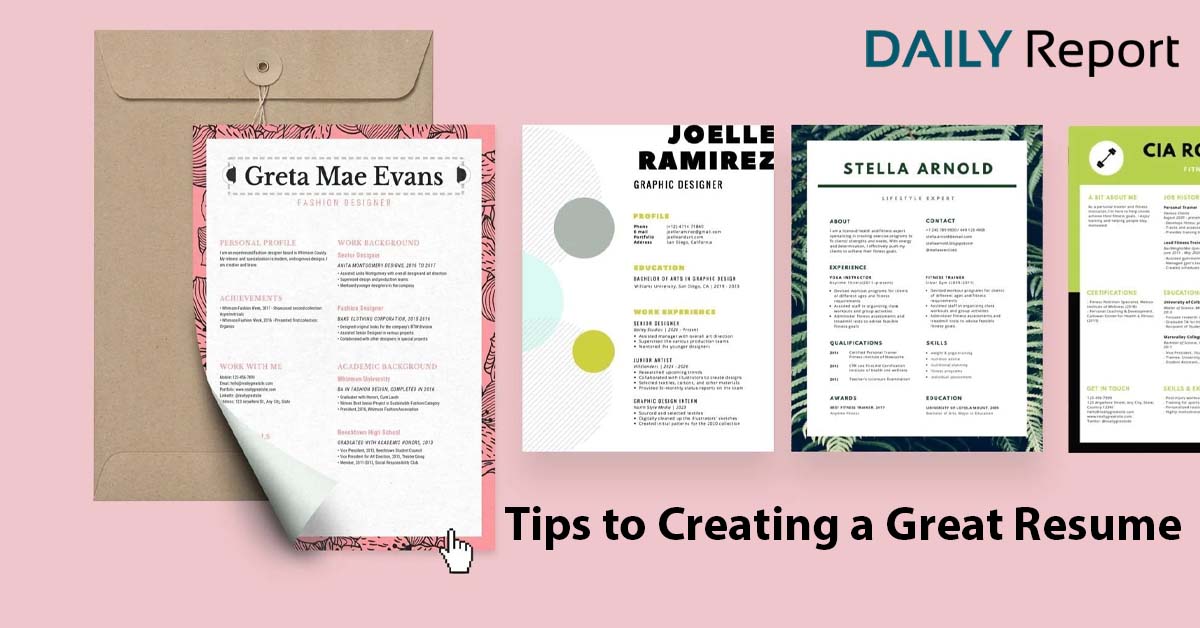Tips for Creating a Great Resume
മലയാളത്തിൽ വായിക്കാൻ ഇവിടെ ക്ലിക്ക് ചെയ്യുക
Your resume is the critical piece of your job application. Here’s how to get it right.
- Employers look at resumes for an average of only six or seven seconds.
- You’ll get the best results if you send your resume between 6 a.m. and 10 a.m. within the first four days of a job being posted.
- Your resume should be clear, concise, and tailored to the job for which you are applying.
- This article is for job seekers who want to improve their resumes to increase their chances of getting an interview.
With the current labor shortage and low unemployment rate, job seekers are at an advantage when it comes to applying for jobs. However, that’s not to say that you don’t need a professionally written resume. Employers still want to find and hire the best employees for each open position, and resumes are the first step in that search. There are several strategies you can use to make your resume stand out and demonstrate that you are the best candidate for the job.
Importance of a resume
Your resume is the most important document you’ll submit in your job search. It’s your frontline fighter, so to speak, as it’s your first opportunity to present yourself to a potential employer. Hiring managers and recruiters look at resumes for an average of only six to seven seconds each, so you must make every second count. A strong resume can help you stand out from the crowd, but a weak resume can remove you from the running.
According to Zippia research, professionally written resumes are not only good for landing an interview, but they can also boost your earning potential by 7%.
Simple resume writing tips to help you stand out
It can be difficult to succinctly present all of your experiences and qualifications on one page, but there are many ways to spruce up your resume without going overboard. To help you land an interview, we rounded up some of the best resume writing tips.
1. Keep your resume short and direct.
The No. 1 rule of writing a resume is to keep it short and to the point. The general rule is no more than one page unless you have a very good reason for it to be longer, like an extensive career or a lot of highly relevant work experience.
An easy way to keep your resume concise is to include only recent, relevant experience. While that yearlong first job might have taught you a lot about the field, it’s not always necessary to include every detail from your entire career history.
Most experts recommend including jobs from the previous 10 or 15 years only, although this time frame may be shorter if you are new to the workforce. Including too many unrelated work experiences can make your resume appear too busy and draw attention away from your relevant qualifications. Your resume should be focused, clear and concise.
2. Create an original resume template.
Employers appreciate originality. While it’s helpful to refer to a professional resume template, don’t follow it rigidly. Zippia found that more than 60% of hiring managers consider a customized resume as the top strategy for job applicants to increase their chance of landing a job.
“I often pass over resumes that match Microsoft Office templates,” Claire Bissot, SPHR, and director of Kainos Capital told us. “The templates are meant to be a guide to get started, but they should be expanded on to make them your own.”
Format your resume so that it is easy to identify your qualifications. For instance, Bissot recommended, if you advanced in a company quickly, draw attention to that growth. If you excessively job-hopped, bullet those jobs without providing specifics and detail about more applicable positions. This will play to your assets.
When structuring your resume, make sure the information is presented in a logical order, said Veronica Yao, owner of CareerProse and marketing communications manager at Fonolo. “A hiring manager [will] read your resume starting at the top and ending at the bottom. However, if they don’t finish reading the whole thing – and they often don’t – you still want to ensure your strongest points come across.”
3. Highlight relevant skills and experiences.
Using the same resume for every job you apply for is not a good approach. Instead, your resume should target the specific job you are applying for. Be sure to prioritize the skills, qualifications, and experiences that are directly applicable to the job you are trying to land.
Choose three or four former positions or experiences that best highlight the skills required for the position for which you apply. Employers value brevity; this is not the time to list every position you have ever held. For example, if you are applying for a marketing position, you could include your former retail experience and bullet the communication, branding, and interpersonal skills you learned in that position.
If you don’t have a work history that directly relates to the job you are applying for, get creative with how you present your other experiences. Draw on the skills you used and how your contributions benefited the organization or project. [Read related article: 38 In-Demand Skills to Help You Get the Job]
4. Demonstrate results with numbers and metrics.
When you write about your previous work experience, it is always a good idea to quantify your successes with numbers. Using metrics can highlight your achievements and give the hiring manager or recruiter a clear sense of how you impacted your previous place of employment. For example, someone who previously worked as a sales representative might say that they “executed more than 50 cold calls daily, with an average 5% conversion rate.”
5. Craft a career snapshot.
More recently, career experts have urged job seekers to do away with the old “objective” statement and instead consider including a summary, called a “career snapshot,” at the top of their resume.
“With the career snapshot, you present a branding statement that briefly explains your unique value as well as your skills and qualifications,” said Tomer Sade, CEO of Book a Space. “This would then be followed by a few bullet points that highlight your experience and your accomplishments. Whatever you list here should be relevant to the position you’re applying to.”
“The top third of your resume is prime resume real estate,” added Lisa Rangel, an executive resume writer, and CEO of Chameleon Resumes. “Create a robust summary to capture the hiring manager’s eye.”
Think of your career snapshot as an answer to the question “How would you describe your work experience in one sentence?” The summary is an opportunity, to sum up, your most relevant and important skills, experience, or assets right off the bat.
6. Optimize your text.
If a company uses an applicant tracking system (ATS) to collect and scan resumes, a human hiring manager may never even glance at any application that doesn’t fit the job criteria they’ve entered. Trish O’Brien, vice president of human capital operations at PSI Services, emphasized adapting your resume to the position to increase your likelihood of passing the first level.
“Make sure you’ve carefully reviewed the posting and … [used] the appropriate keywords in your resume to get past the screener,” O’Brien said. “Be truthful, but understand that the first pass on your resume is likely via an ATS.”
A helpful tip is to make sure you include keywords from the job post in your resume. You can copy and paste the job description into a word-cloud generator to identify the most frequently used terms, and make sure the terms that apply to you are used in your resume. You can also create a “core competencies” or “areas of expertise” section of your resume to list all of your hard and soft skills, and then reiterate those skills when you bullet your experience.
7. Think beyond your job duties.
Hiring managers don’t want to read a list of your job duties. They want concrete examples of your accomplishments in previous positions that show how you can make a difference in this new position.
Rangel said that specific merits are more engaging to read than just your experiences. For example, “I reduced operating expenses by 23% in six months” is far more interesting to an employer than “I have 30 years of sales experience.”
When deciding what information to keep or cut out of your resume, focus on striking abstract traits and qualifications in favor of concrete, quantifiable results.
“The best resumes highlight a job candidate’s actions and results,” said Bob Myhal, director of digital marketing at CBC Automotive Marketing. “Employers want employees who get things done and who take great joy and pride in what they do. Rather than a laundry list of your qualifications, your resume should reflect your accomplishments and enthusiasm for your career.”
You shouldn’t ignore your skills section either. Sade reminded job seekers to list any industry-relevant apps or programs they’re familiar with and to find ways to incorporate examples of their emotional intelligence (e.g., self-awareness, empathy) and soft skills (e.g., work ethic, reliability) into their job descriptions.
8. Use the right language to stand out.
Trite, lackluster descriptions of your job duties and accomplishments won’t do you any favors. Make sure you’re using strong action words, such as “achieved,” “designed,” “improved” and “established,” to describe your roles and projects, said Sade. This will make you sound confident while imparting vital information. But be cautious about depending on action verbs – make sure to include details about how you improved a process or achieved a goal.
“Words such as ‘professional,’ ‘results-driven’ and ‘detail-oriented’ provide very little helpful information,” Sade said. “It’s better to use actual job titles than these words.”
Diya Obeid, founder, and CEO of ATS company JobDiva said that you should remove words like “go-getter,” “team player” and “go-to person” from your resume. These come off as fluff and take up precious space on your resume.
9. List your social media profiles.
Many hiring managers today screen candidates on social networks. Save them a step by providing your profile links on your resume. Seasoned applicants with a professional social presence would do well to include URLs for their LinkedIn profile, Twitter account, and blog, if applicable.
“If, and only if, your social media accounts are filled with professional posts about your industry, listing them on your resume can be advantageous,” said Richie Frieman, author of REPLY ALL … and Other Ways to Tank Your Career. “They can show you have a strong network and are up to speed with modern-day marketing and communications practices. The hiring manager will see that you like to keep up with what’s happening and that you care about learning more.”
Your social profiles can be a powerful recruitment tool to supplement your experience and position as an expert in your field, but only if they are leveraged correctly.
10. Check for errors.
Triple-check your work, and then have someone else look over your resume to ensure it’s 100% clean. There is no room for sloppiness on your resume.
- Spelling, grammar, and punctuation: A hiring manager will likely automatically dismiss your application if they spot a typo or grammatical error. “Make sure it’s error-free and easy to read,” Obeid said. “HR reps equate typos and errors with laziness. Use good English – the written word has a huge impact on the employer.”
- Formatting: “Review formatting very closely, including font, alignment, and spacing,” Bissot said. “Related issues can often be perceived as a sign of lacking technical skills and/or attention to detail.”
- Headings: Yao said that candidates often submit applications addressed to the wrong employer or outline experience that’s irrelevant to the role. “Receiving a resume that’s crafted and addressed to someone else – or worse, a competitor – can be a huge turnoff and will set a negative tone even if they do choose to continue reading your application.”







